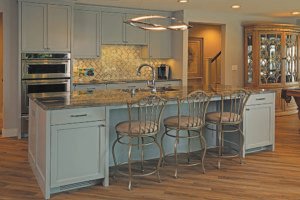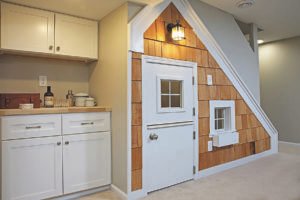 Longfellow contractor Phillip Hide can often make a bathroom or kitchen work better by reconfiguring the space. (Photo submitted)
Longfellow contractor Phillip Hide can often make a bathroom or kitchen work better by reconfiguring the space. (Photo submitted)COVID-19 has changed the remodeling business for Longfellow resident Philip Hide of Wise Design and Remodel.
These days, he’s more likely to meet with clients for their consultations over video calls rather than face-to-face.
He’s also asking himself if he really needs to check in with contractors at the site when the project starts or whether the visit can be done via video call for efficiency and to reduce personal contact. It varies, as being on site to assess job details is an important part of his job.
Hide thinks these changes will probably stay around after COVID-19. He’s glad for the them as they fit with the sustainable way he lives and works, and it is helping him reduce his carbon footprint while saving valuable time.
Dividing up jobs, spacing out workers
Following CDC guidelines, wearing masks, social distancing when possible, and good cleaning processes are just part of it of the considerations around COVID-19 for Wise Construction.
“It’s really a case-by-case basis,” said Hide. “I’ve had to navigate with customers’ needs individually. Interior remodeling is particularly difficult with people working from home more. We need to make everyone involved feel safe and still get some work done.”
He focuses on larger remodeling projects, and has found himself dividing them into stages in order to minimize the disruption to clients’ homes. When a client moves out into temporary housing or with family, they are able to do work throughout the house. But for those who are living, working and going to school in the home during the work project, they take another approach.
Dividing up the job isn’t as efficient, but it enables them to partition off the section they’re currently working on with plastic barriers, and ventilate it well with air scrubbers, in addition to opening the windows for natural ventilation where possible.
Hide works closely with clients to communicate when they need to go into other parts of the house, such as the basement to reach the electric panel or turn off the water, so that the homeowner is able to leave the house for a few hours and they can wipe off high surface areas.
For safety reasons, Hide has spread the projects out farther than before. Where a job might have taken eight weeks previously, now it takes 10. He makes sure that the plumbers aren’t in the house at the same time as the electricians, in order to minimize everyone’s exposure as much as possible.
Things are also slower when it comes to inspections and ordering. Each city in the metro has been operating differently since March, and staff have varying protocols they follow. Some materials are taking a long time to order due to manufacturing processes being slowed down.
Hide also navigates differing comfort levels with his subcontractors, and focuses on everyone operating sensibly and respectfully. He sets the safety standards as the general contractor.
Despite the inconveniences, Hide is grateful to be busy as he knows that other industries have been hit hard by the pandemic.
 Phillip Hide made use of space under a stairwell by transforming it into a playhouse. (Photo submitted)
Phillip Hide made use of space under a stairwell by transforming it into a playhouse. (Photo submitted)Finding creative solutions
After working in the family business in London, England for a decade, Hide started his own remodeling firm and operated that for seven years. His experience remodeling older homes and making the most of smaller spaces has given him a unique perspective on his work in Minneapolis today.
“Many of the homes we worked on in North London were built from around 1880 to 1930 and sometimes much older. There were often challenges with small spaces, old plumbing, hazardous materials and sometimes interesting structural issues to deal with. Finding effective and creative solutions was very satisfying,” he said.
Hide met his wife Juli while she was studying abroad in London and they married in 2007. They moved to South Minneapolis in 2014 to be closer to her family, and are raising their three children in Longfellow.
Environmentally-friendly decisions
Right now, he sees families carving out more privacy for an office area in basements and attics. “People want to explore having us design a space that currently isn’t being used efficiently,” said Hide.
Some clients think they need a large addition to create this space, but Hide often saves them money by figuring out how to use their existing space better and doing small additions instead when possible. Other options they do frequently is bumping out dormers.
“Many houses are badly designed. They can be laid out in a more efficient manner, particularly kitchens and bathrooms,” stated Hide.
Hide’s work earned him the 2018 and 2019 NARI Newcomer’s Award from the National Association of the Remodeling Industry.
He’s certified through the EPA Lead-Safe program, and plans to spend his slower winter months evaluating other sustainable practices he can work into his business in 2021.
“Utilizing an existing space can be a environmentally friendly decision,” he pointed out. So can using materials that may be more expensive to start with but stand the test of time and can be sustainably sourced.
Wise considers factors such as whether a product is shipped from far away or whether it was quarried or made in Minnesota or the Midwest when helping clients evaluate their options.
“COVID-19 has created some environmental efficiency for us, particularly in how we travel and use technology,” said Hide. “That’s something positive we can take away from this and continue to improve on.”
Comments
No comments on this item Please log in to comment by clicking here